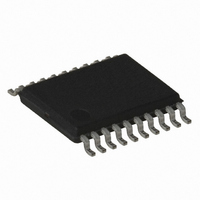ATTINY167-15XD Atmel, ATTINY167-15XD Datasheet - Page 29

ATTINY167-15XD
Manufacturer Part Number
ATTINY167-15XD
Description
MCU AVR 16K FLASH 15MHZ 20-TSSOP
Manufacturer
Atmel
Series
AVR® ATtinyr
Datasheet
1.ATTINY167-15MD.pdf
(283 pages)
Specifications of ATTINY167-15XD
Core Processor
AVR
Core Size
8-Bit
Speed
16MHz
Connectivity
I²C, LIN, SPI, UART/USART, USI
Peripherals
Brown-out Detect/Reset, POR, PWM, Temp Sensor, WDT
Number Of I /o
16
Program Memory Size
16KB (8K x 16)
Program Memory Type
FLASH
Eeprom Size
512 x 8
Ram Size
512 x 8
Voltage - Supply (vcc/vdd)
2.7 V ~ 5.5 V
Data Converters
A/D 11x10b
Oscillator Type
Internal
Operating Temperature
-40°C ~ 150°C
Package / Case
20-TSSOP
Processor Series
ATTINY1x
Core
AVR8
Data Bus Width
8 bit
Data Ram Size
512 B
Maximum Clock Frequency
16 MHz
Maximum Operating Temperature
+ 85 C
Mounting Style
SMD/SMT
3rd Party Development Tools
EWAVR, EWAVR-BL
Development Tools By Supplier
ATAVRDRAGON, ATSTK500, ATSTK600, ATAVRISP2, ATAVRONEKIT
Minimum Operating Temperature
- 40 C
For Use With
ATSTK600-SOIC - STK600 SOCKET/ADAPTER FOR SOIC
Lead Free Status / RoHS Status
Lead free / RoHS Compliant
- Current page: 29 of 283
- Download datasheet (5Mb)
4.2.5
7728G–AVR–06/10
Low-frequency Crystal Oscillator
The CKSEL0 Fuse together with the SUT1..0 Fuses or CSEL0 together with CSUT1..0 field
select the start-up times as shown in
Table 4-7.
Notes:
To use a 32.768 kHz watch crystal as the clock source for the device, the low-frequency crys-
tal oscillator must be selected by setting CKSEL fuses or CSEL field as shown in
page
Crystal Oscillator Application Note for details on oscillator operation and how to choose appro-
priate values for C1 and C2.
The 32.768 kHz watch crystal oscillator can be used by the asynchronous timer if the
(high-frequency) Crystal Oscillator is not running or if the External Clock is not enabed
”Enable/Disable Clock Source” on page
itself this low-frequency crystal oscillator.
CKSEL0
CSEL0
0
0
0
0
1
1
1
1
25. The crystal should be connected as shown in
1. Flash Fuse bits.
2. CLKSELR register bits.
3. These options should only be used when not operating close to the maximum frequency of
4. These options are intended for use with ceramic resonators and will ensure frequency stabil-
5. This setting is only available if RSTDISBL fuse is not set.
(2)
(1)
the device, and only if frequency stability at start-up is not important for the application.
These options are not suitable for crystals.
ity at start-up. They can also be used with crystals when not operating close to the maximum
frequency of the device, and if frequency stability at start-up is not important for the
application.
Start-up Times for the Crystal Oscillator Clock Selection
CSUT1..0
SUT1..0
10
01
00
01
11
00
10
11
(5)
(5)
(1)
(2)
Start-up Time from
Power-down/save
16K (16384) CK
16K (16384) CK
16K (16384) CK
1K (1024) CK
1K (1024)CK
1K (1024)CK
258 CK
258 CK
Table
(3)
(3)
32.). The asynchronous timer is then able to start
(4)
(4)
4-7.
(4)
Additional Delay
14CK + 4.1 ms
14CK + 4.1 ms
14CK + 4.1 ms
14CK + 65 ms
14CK + 65 ms
14CK + 65 ms
(Vcc = 5.0V)
from Reset
14CK
14CK
ATtiny87/ATtiny167
Figure
4-3. Refer to the 32.768 kHz
Recommended Usage
Ceramic resonator, fast
rising power
Ceramic resonator, slowly
rising power
Ceramic resonator, BOD
enabled
Ceramic resonator, fast
rising power
Ceramic resonator, slowly
rising power
Crystal Oscillator, BOD
enabled
Crystal Oscillator, fast
rising power
Crystal Oscillator, slowly
rising power
Table 4-1 on
(See
29
Related parts for ATTINY167-15XD
Image
Part Number
Description
Manufacturer
Datasheet
Request
R

Part Number:
Description:
Manufacturer:
Atmel Corporation
Datasheet:

Part Number:
Description:
Manufacturer:
Atmel Corporation
Datasheet:

Part Number:
Description:
MCU AVR 16K FLASH 15MHZ 32-QFN
Manufacturer:
Atmel
Datasheet:

Part Number:
Description:
IC MCU AVR 16K FLASH 20TSSOP
Manufacturer:
Atmel
Datasheet:

Part Number:
Description:
MCU AVR 16K FLASH 15MHZ 32-QFN
Manufacturer:
Atmel
Datasheet:

Part Number:
Description:
MCU AVR 16K FLASH 15MHZ 20-SOIC
Manufacturer:
Atmel
Datasheet:

Part Number:
Description:
MCU AVR 16K FLASH 15MHZ 20-TSSOP
Manufacturer:
Atmel
Datasheet:

Part Number:
Description:
IC MCU AVR 16K FLASH 20SOIC
Manufacturer:
Atmel
Datasheet:










